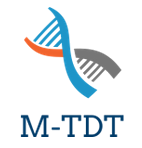
Tools and Web Service work Package
M-TDT tool Documentation.

M-TDT (Multi-locus Transmission Disequilibrium Test) is an open source program computing a family-based statistic testing for association between a phenotype and a set of multi-allelic markers. The program is for family-based genome-wide screening of single and joint effects of genetic mutations on infectious disease traits, either qualitative or quantitative traits, regardless of phenotype distribution.
- Many studies in Africa with recruitment in families (trio, nuclear families data)
- Study of Infectious disease (multifactorial diseases, complex traits)
- Need statistical analysis methods and tools to handle data from such studies
- Ability to find joint effects of several markers impacting phenotypes in a context of small sample size
- Retrieve markers that would be missed by classical approaches
- Handles of main statistical issues like:
- non-specified distribution of traits
- related individuals
- population admixture
- linkage disequilibrium among markers
Family-based design
There is two ways to use M-TDT:
- Command-line : Here is the link to the CLI https://github.com/avalanche-org/m-TDT
- The Graphical User Interface, which will be detailed
You can use the tool currently deployed on the Institut Pasteur servers: (link)
If you want to install the GUI version locally you have two ways to do so:
You need to install :
1 - Clone repository
$ git clone https://github.com/avalanche-org/Gen_Assoc.git
2 - Move to Gen_Assoc/apps folder and install the required dependencies
$ cd Gen_Assoc; cd apps
$ npm install
3 - Run the application
$ npm run build
Open your browser and type http://localhost:4000/
Here your are !
To stop the application, type Ctrl+c in terminal. If the application crashes, type Ctrl+c and rerun npm run build
2. Docker
For this section Docker (Docker) is required.
The Webservice Application docker image is available on docker registry
Open your terminal:
docker pull jukoo/m-tdt:stablev1
To launch the docker application
$ docker run -d -p <localport>:<containerPort> jukoo/m-tdt:stablev1
The default port of the container is 4000
example:
💡 If you get a warning indicating a platform mismatch between the requested platform for the Docker image and the platform detected on the host machine, then add `--platform linux/amd64` to the command
docker run -d -p 3000:4000 jukoo/m-tdt:stablev1
Open your browser and type http://localhost:3000/
Here you are 🚀




